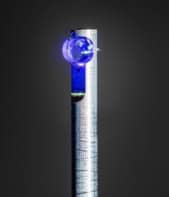
In a bid towards better understanding the inner workings of the proton, researchers in Germany have, for the first time, directly measured magnetic spin-transitions of a single trapped proton. Their work is an important step forward in understanding the magnetic properties of a proton. The technique could also be used to measure the spin of an antiproton, which could help us understand why the universe has more matter than antimatter.
The proton has an intrinsic angular momentum or spin, and behaves like a tiny bar magnet that can point up or down. The spin of a single proton has not been measured until now because the magnetic moment of the proton is much smaller and hence more difficult to detect, than that of the electron or the positron. Previous measurements have been made on clouds of protons which cannot be repeated on the much more scarce antiprotons. This new method looks at measuring the spin of just one proton produced and held in a special trap, which is capable of storing protons for months.
The researchers, based at Johannes Gutenberg University and the Helmholtz Institute in Mainz, Germany, together with colleagues from the Max Planck Institute for Nuclear Physics in Heidelberg and the GSI Helmholtz Center for Heavy Ion Research in Darmstadt, Germany, spent close to five years working on their experiment. One of the main developments was a specially designed miniature Penning trap – a vacuum trap that uses electric and magnetic fields to hold particles. “Such an experiment is challenging and has to be set up with extreme care.” explains Stefan Ulmer, a team member from the Helmholtz Institute. “In the first two years we designed the cryogenic apparatus, the Penning traps and the highly sensitive superconducting detection systems. In the third year we got the apparatus running and succeeded in preparing a single proton. In the following two years we had to improve the apparatus and redesign some parts. Finally we succeed after four and a half years in observing a single proton spin flip.” he said.
Wobbling protons
A proton in a Penning trap aligns its spin with the trap’s magnetic field. The team introduced an additional magnetic filed, which creates a non-uniformity. The team then switched on an RF signal that causes the spin to precess or “wobble” like a spinning top. The non-uniform magnetic field causes the frequency of the wobble to depend on the direction of the spin. As a result, a spin flip can be detected by measuring a small change in that frequency, which can unobtrusively be detected. This can then be used to calculate the proton’s magnetic moment.
Because the proton spin is still small, currently the researchers have measured it to a precision of 10–4. “The aim is the measurement of the magnetic moment of the single proton with a precision of 10–9, at least. We are right now working on the improvement of the apparatus to reach the 10–9 level.” explains Ulmer.
Looking towards antimatter
In the near future, the researchers would like to apply their methods to measuring the magnetic moment of antiprotons – the antimatter counterpart of the proton. This would be carried out at research facilities where low energy antiprotons (5.3 MeV) are produced, such as the CERN Antiproton Decelerator (AD). “If the proton is measured, it will be possible to measure the antiproton. Currently there is only one facility worldwide which delivers antiprotons – CERN AD. Lots of groups want to have access, so it is a question of how it can be organized to get access. Such antiprotons are needed to perform high-precision low-energy experiments with antimatter. The antiprotons from CERN AD would be decelerated and stored in our Penning trap.” says Ulmer. Another facility in Germany called a Facility for Low Energy Antiproton and Ion Research (FLAIR) has been set up to provide low-energy antiprotons, but it will be quite some time before FLAIR is operational.
Jeffrey Hangst, who works at the ALPHA experiment at CERN AD, says “This is a very difficult and elegant experiment; I am very pleased that they have achieved this important milestone. We should put matter and antimatter under the microscope when we have a chance to do a beautiful experiment like this one.” Even with ALPHA’s advance, it will be difficult to make magnetic measurements of the antiproton because that is not sufficient time. Currently, the magnetic moment of the antiproton is known only to three decimal places. The team hopes that its method will change this and help to conduct high-precision comparisons of the fundamental properties of particles and antiparticles, making it possible to accurately determine whether CPT symmetrical behaviour actually occurs, and maybe provide the basis for theories that extend beyond the Standard Model.
The research was published in Physical Review Letters.



